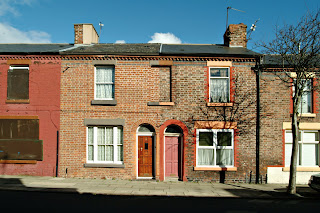 |
| 'Coronation Street' terraces in East Manchester, demolished last year despite fierce opposition from local residents and SAVE |
Madryn Street, and several hundred other houses in the Welsh Streets area of the city, has been earmarked for demolition by Liverpool Council as part of a Pathfinder scheme. SAVE has long been a fierce critic of Pathfinder and, in April this year, we published our latest
e-report attacking the programme.
The Housing Market Renewal (Pathfinder) Initiative was dreamt up by the previous government. Although the initiative aimed to tackle 'housing market failure' in post-industrial northern towns and cities, the result has been a catastrophe - homes and communities have been destroyed and, in most places, the promised regeneration has not taken place. It has been the most destructive government housing initiative since the mass demolitions of the 60s and early-70s. Now the Pathfinder scheme has been discontinued but some councils, including Liverpool, are pursuing demolitions, even though the state funding for new housing is no longer available.
 |
| Good 19th-century housing in Gateshead, boarded up and flattened without any plans for future development |
|
Our report, written by Jonathan Brown and Bill Finlay, levels 10 charges against Pathfinder and makes 5 recommendations. The charges are:
- Pathfinder prevented market correction – 1990s low demand and ultra low house-values proved a passing phenomenon, and soon became a relic as the economy grew - but Pathfinder ‘sealed in the rot’. Heseltine and Prescott's best work on urban renaissance was stopped from reaching the inner city communities who needed it most.
- Pathfinder talked places down – inner Liverpool was characterised as an obsolete urban hell by quangocrats - no way to restore investor confidence, and a travesty of a historic metropolitan core rich with complex communities and strong architectural character.
- Pathfinder diagnosed the wrong causes – population decline, jobs and access to them are the real problem, not low house prices or terraced streets, which are often solutions to attracting new residents.
- Pathfinder prescribed the wrong medicine – demolition of the very streets that sustain urban living, and replacement by low density standard layouts just repeats 60s errors and accelerates cycles of decline.
- Pathfinder ignored sensible solutions – housing refurbishment grants and environmental upgrades are well tried and far better value packages of regeneration improvements - demolition was too often a first resort to facilitate major land deals.
- Pathfinder distorted local democracy – councils chased the grant despite the damaging terms, and suppressed opposition through sidelining and spin. CPO and eviction became a mainstream activity, with social landlord and developer interests placed before those of individual householders.
- Pathfinder rewarded failure – Social landlord executives and quango bosses grew rich while ordinary people lost hard-won equity averaging £35,000. Housing management problems were disguised as market failure, and monopoly land banks built up with huge public subsidy.
- Pathfinder killed local economies – removal of people means removal of networks of exchange. Empty streets mean no customers for the shops, no locals in the pub and no cars to be repaired. The huge negative externalities of investment forgone, residents displaced, tax revenues lost, opportunity costs and damaged confidence have never been accounted for.
- Pathfinder worsened social deprivation and housing need – In Liverpool, housing waiting lists have doubled and entire districts blighted. Shelter condemned increased overcrowding. Civic pride is corroded. How do you ask children not to drop litter when the council have boarded up their neighbourhood?
- Pathfinder was environmentally stupid – In enlightened hands £2.2bn could have pioneered low carbon retro-fit technology and kick-started green economies, giving deprived areas a head-start in building skills and supply chain networks to compete in rapidly expanding markets.
 |
| Ducie Street, Granby, Liverpool. A street of very fine Victorian homes, demolished and grassed over by the council in 2010 |
The report makest the following recommendations:
New funding should be targeted mainly at repair and refurbishment, and decisions placed in the control of individual occupants and owners, as were the successful area-based grant schemes 20 - 30 years ago.
Mega-Social-Landlords driven by development ambitions must be brought under tight democratic control to make them better neighbours – 70% of their income is publicly funded grant and housing benefit. They must be subject to Freedom of Information Act legislation, proper scrutiny and limits on their monopoly ownership of entire communities. If necessary, they should be broken back down into smaller tenant co-ops and housing associations, as was their original intent. The HCA should not be both funder and auditor.
Area-based retro-fit to high environmental standards will help renew market confidence and generate economic opportunity in deprived areas much more effectively than expensive HMR quangos.
The constitutional implications of Compulsory Purchase Order powers over private home owners need to be carefully reviewed by Parliament – at present, 95% of orders are granted, with new ‘Localism’ and Big City Mayoral powers extending their reach yet further. CPO of homes should be a last resort, not a mainstream activity.?
A more respectful approach to deprived neighbourhoods that does not assume those with power necessarily know best – community regeneration should be about creative ways to revalue what is there, rather than aggressively seeking to remove it altogether. Sometimes traditional urban forms are popular simply because they work.
-----------------------------------------------------------------------------------------------------------------
The Report with Introduction by Jonathan Brown and Critique by Finlay Research, is now available as 3 PDF files from
Here








 0
0



































